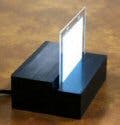Initial research findings indicate that Osram's white OLEDs can achieve a luminous efficacy of up to 25 lm/W. At brightness levels suitable for general lighting applications, the OLED efficacy is18 lm/W, making the devices superior in this respect to conventional light bulbs (typically 12 lm/W) and almost on a par with halogen lamps (20 to 26 lm/W).
While Osram Opto continues to develop polymer-based solutions for displays, it is now also focusing on small-molecule technology for illumination applications with OLEDs.
Research and development efforts in Regensburg, Germany, will focus on the design and implementation of specific device architectures for OLEDs, as well as increasing their efficiency and lifespan, and also scaling the devices to larger areas. Experts are also involved in creating the right conditions for high-volume production.
OLEDs can be constructed as extremely thin light sources with large surface areas, and could be used for signage and information systems. In the medium term, OLEDs are likely to be produced on transparent, contoured or even flexible substrates and may even one day be used as illuminated wallpaper or for low-profile high-definition wall-mounted screens.
Osram Opto Semiconductors is taking part in the OLLA project (Organic LEDs for ICT & Lighting Applications) organised by the European Union and in the OLED Initiative 2015 organised by the German Federal Ministry of Education and Research.
White OLEDs reach 64 lm/W efficacyIn July, the Japanese company Konica Minolta reported a white OLED with a luminous efficacy of 64 lm/W and a luminance of 1,000 cd/m2, as well as an expected time to half brightness of 10,000 hours.
The company intends to focus on lighting applications, but will have to make lifetime improvements if the OLEDs are to be built into semi-permanent wall or ceiling panels, as distinct from replaceable lamps (compact fluorescent lamps typically last for about 6000 hours).







